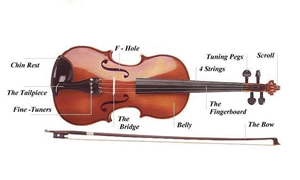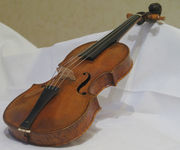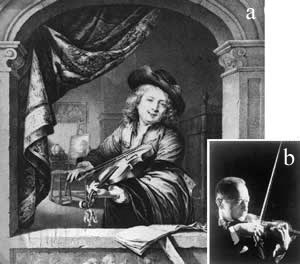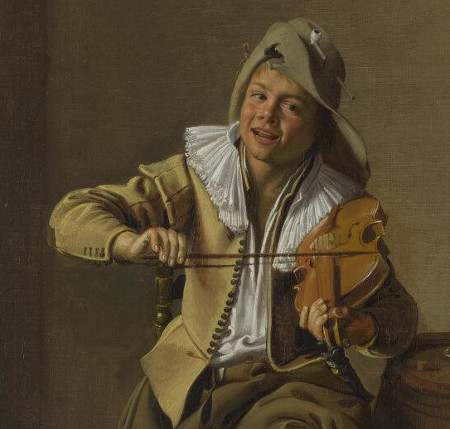Ancestors of the Fiddle
During the Middle Ages and early Renaissance, the words ffythele, ffidil, fiele and fithele were used not only for bowed instruments, but for what today is known as the medieval fiddle, the predecessor of the violinne and a key instrument played by the minstrels.
The earlier form the viella-da-gamba was played downwards, on the musician's lap during festivals or ceremonies, the bow gripped from below (in the manner of the later viol of the Renaissance). Instead, the medieval fiddle was held against the chest or the shoulder freeing the performer to walk about during banquets, festivals or ceremonies. The well-known panel painting by the Flemish painter Hans Memling shows at the far right side an angel playing a medieval fiddle (fig. 1 & 1a). It has a gently curved bridge and five strings, which suggests that medieval musicians often bowed two strings together, one of the main characteristics of the fiddling styles for dance music.
Hans Memling
c. 1480
Oil on wood, 165 x 230 cm. (each panel)
Koninklijk Museum voor Schone Kunsten, Antwerp Koninklijk Museum voor Schoone Kunsten, Antwerp

Another early predecessor of the fiddle was the rebec, which evolved from the Byzantine lūrā and the Arab Rabāb (fig. 2). Rebec-type instruments have been known in Europe under different names and forms from the late tenth century to the present day (still played by early music groups), but were particularly popular in the fifteenth and sixteenth century. Just as the rebec's shape varied, so did its size and number of the strings. Rebecs with one to five strings were quite usual. Its pear-shaped back was generally carved from a single piece of hard wood tapering so that no visible distinction remained between the body and the neck. Like the violin in earlier times, the rebec was held against the chest or the upper arm, the preferred position in northern Europe, while the downward position was favored in the south (southern Europe, northern Africa).

The Temptation of Saint Anthony in the Grotto by David Teniers the Younger (fig. 3) recalls Hieronymus Bosch's great triptych with the same subject. It features a human-like creature looking out at the spectator as he plays a rebec. Another disquieting creature with an animal's skull accompanies him with the bagpipe.
This depiction demonstrates that this precursor of the fiddle was restricted to elevated environments, but was appreciated by common people. A piece of period fiddle music (below right) furnishes an excellent example of seventeenth century country dance performed on an ancient rebec. This kind of music brings to life the numerous Dutch and Flemish genre paintings of common people dancing at a tavern or kermis. Another painting by David Teniers (fig. 4) shall stand here for all the others. A fiddler and a bagpipe player entertain rustic peasants as they hurl themselves into dance.

David Teniers the Younger
c. 1640
Oil on panel 44.5 x 56 cm.
Gemäldegalerie Alte Meister Dresden

David Teniers the Younger
1641
Oil on canvas, 93 x 132 cm.
Gemäldegalerie Alte Meister Dresden
The history of the violin / fiddle
The shape of today's violin emerged from northern Italy in the early sixteenth century. The area, including Brescia and Cremona in particular, had an outstanding tradition in instrument building, especially lutes and viola da gambas. Soon, the violin spread throughout Europe and became immediately popular with street musicians and nobility alike.

National Music Museum. University of South Dakota.

Jan Steen
c. 1670–1672
Panel, 39 x 49.5 cm.
Private Collection
The earliest documented violin with four strings was constructed in 1555 by Andrea Amati from a flourishing family of violin makers of Cremona (fig. 5), the main center of European violin making till this day. Andrea developed the profile from the pointed form of the gamba. In 1560, the French king Charles IX ordered Amati to construct 24 violins. The oldest surviving violin, dated inside, is from this very set and therefore known as the "Charles IX," made in Cremona c. 1560. Other famous violin makers, initially called luthiers, between the late sixteenth and the 18th century included the Guarneri family (Mantua, Cremona), the renowned Stradivari family of Cremona, the Gagliano family or Giovanni Battista Guadagnini of Piacenza. Several German-speaking areas nurtured a similar tradition in violin making, such as the Vogtland (Saxony, here especially the cities Markneukirchen and Klingenthal, still world-known for instrument making), Mittenwald and Füssen (Bavaria), or Tirol (Austria, here above all the famous Jacob Stainer, 1617–1683, of Absam).
Significant alterations occurred in the construction of the violin in the 18th century, particularly in the length and angle of the neck, as well as a heavier bass bar. To this day, instruments from the "Golden Age" of violin making, especially those made by Amati, Stradivari and Guarneri del Gesù, are the most sought-after instruments by collectors and performers. They set the standard for perfection in sound and craftsmanship so much that violin makers of all over the world have attempted to adhere as closely as possible to this ideal. Since the violin appeared during the seventeenth century, it has been the body of "strings" (i.e. the violin family in an orchestra) and the most important defining factor of any Western orchestra, whether the large "classical" one or the small ensemble for chamber music.
Adriaen van Ostade
1673
Oil on panel, 45 x 42 cm.
Mauritshuis, The Hague
But the costly violins made by renowned luthiers were not the only ones to be built. Long ago, common people had found the violin ideal for dance music, and so cheap instruments, with native variants, were eagerly imported by almost all western European countries as far north as Scandinavia. The abundance of fiddles stimulated the development of fiddling traditions, above all in Ireland, Scotland and to a lesser degree in England and Wales. Although the custom of concerted playing gradually developed along with fiddlers' societies and specialized dancing venues, the importance of the private "session," small informal groups of instrumentalists, remained as entrenched as ever.
Many popular tunes in the Netherlands were imported by itinerant fiddlers. The Dutch people's love of the fiddle is apparent not only in the great number of the depiction of fiddlers but in some of the finest pictures of the violinist, be it a fanciful dressed musician in half-size or a humble figure of itinerant fiddler.
A comparison of four seventeenth-century paintings reveals the difference between various artists. The diversity in mood and technique range from Adriaen van Ostade's cool, transparent atmosphere to the pointed chiaroscuro of the Utrecht Caravaggionist Gerrit van Honthorst (fig. 7), from Gerard Dou's scrupulously executed fine-painting (fig. 8) to the broader, charged brushstrokes and preference of light colors by Jan Steen (fig. 6).
It is very likely that both Dou and Steen portrayed themselves as violin players since Dutch painters frequently painted themselves as musicians demonstrating that the painter derives inspiration for his art from music.
Gerrit van Honthorst
1623
Oil on canvas, 108 x 89 cm.
Rijksmuseum, Amsterdam
Gerrit Dou
1653
Oil on canvas, 32 x 20 cm.
Museum Liechtenstein
Click here for period fiddle music played on the Medieval fiddle:
Trouvère: Quarte Estampie Real
From many of these paintings it is possible to construe that the fiddle is a very complex, sensitive instrument consisting with a number of components strained by an enormous tension between them. Besides, the violin is one of the most difficult instruments to master. It requires time to learn the intricate fingering and bowing techniques. Incessant practice is necessary to play "in tune" the rapid scales and learn how to command the bow, essential for traditional dance music. On the other hand, the fiddle possesses a beauty and emotional appeal that comes closest to the tone of the human voice. At the same time is capable of agility and brilliant figuration. Its capacity for sustained tone is remarkable, and no other instrument can produce so many nuances of expression and intensity. To learn how it works, we will take a look at first at the structure of the violin, which, as already said above, is called a fiddle when played as a folk instrument, so that some focus will also be laid on the specifics when used as a fiddle. Then we will learn something about playing techniques.
The structure of the violin
The Baroque Violin and the Modern Violin: Similar, but very Different
BaroqueBand
A violin with its distinctive "hourglass" shape is made of many components: the top plate (or belly), made of well-seasoned spruce, maple ribs and back, a tailpiece to fasten the strings, a bridge, the f-holes or soundholes at the "waist" of the instrument, a neck with the fingerboard, a soundpost (inside the instrument), a pegbox housing the four tuning pegs for the strings (in former times made of catgut, still employed today for Baroque instruments) ending in a scroll (fig. 9). Modern instruments have various fittings, including a chinrest, which may attached directly over, or to the left of the tailpiece, and at least one fine-tuner for the E-string (nowadays made of plain or gold-plated steel), attached on the tailpiece.



The front, back and ribs are joined together to form a hollow soundbox. The soundbox (fig. 9) contains the soundpost, a thin, dowel-like stick of wood wedged inside underneath the right side of the bridge which connects the front and back of the violin; and the bass-bar, a long strip of wood glued to the inside of the front under the left side of the bridge. The soundpost and bass-bar are important for transmitting sound, they also provide additional structural support.
The bridge is made of a precisely cut piece of maple that forms the lower anchor point of the vibrating length of the strings and transmits their vibration to the body of the instrument. Its top curve holds the strings at the proper height from the fingerboard in an arc, allowing each to be sounded separately by the bow.
One slight difference between a "fiddle" and an ordinary violin is a small change of the bridge. Fiddlers often prefer a less curved bridge, which makes it easier for them to rapidly play double stops, and makes triple stops possible, allowing one to play chords, one of the prime characteristics fiddle music.
The neck is usually made of maple. It carries the fingerboard, typically made of ebony, because of its hardness, beauty and superior resistance to wear, as the maple neck alone is not strong enough to support the tension of the strings without bending, relying on its lamination with the fingerboard for strength.
The strings are fastened to the tailpiece. They rest on the bridge, suspended over the fingerboard, and run to the pegbox, where they are attached to the tuning pegs (commonly made of rose wood) that can be turned to change the pitch of the string.
 Fig. 10
Fig. 10 A modern violin bow


Violins of the Baroque period are distinct in a number of features from their modern counterparts. The neck, usually shorter than those of modern instruments, projects straight out from the body so that its upper edge continues in line with the belly's rim. The fingerboard is wedge-shaped and, again, shorter than the modern fingerboard. Bridges were cut to a more open pattern and were very slightly lower. The bass-bar was shorter and lighter and the soundpost thinner. Baroque violins (and violas) lacked chinrests, as they usually rested at the chest or collar-bone. Their tone is brighter, clearer, but produce inferior volume (partly due to the use of catgut strings) and are less "mellow" than those of their modern counterparts.
As the violin is usually played with a bow (fig. 10) essential fiddling as well, a closer look to its structure and slightly different forms may be instructive.
A violin bow consists of a wooden stick, usually made of Pernambuco, a hard but very flexible reddish wood from Brazil (hence sometimes called "brazilwood"). The bow's ribbon (fig. 11) has about 150 horsehairs from the tail of "white" (technically, gray) male horses, preferably those from northern climates, since their hair provides more friction. The increased length (see the following) together with the downward curved form of the stick are the results of the upcoming long melodic lines in the music of the Classical and Romantic period. This form of a violin bow, used until today, was developed by the French bow maker Franz Xavier Tourte (1747–1835) according to suggestions of the famous Italian violinist and composer Giovanni Battista Viotti (1755–1824).
The hairs are fixed in a groove inside the head of the bow and to a nut in a movable frog that slides along the stick allowing one to tighten or loosen the hairs with the help of a screw adjuster. A typical violin bow may be c. 74.5 cm. overall and weigh about 60 g and is made by specialized bow makers.
Before using the bow, the hairs must be prepared by rubbing them with violin rosin, a resin made of pines and other conifers, to increase the friction capacity of the bow, and therefore to enhance the sound production.
The bows used in earlier centuries, however, differ to some degree from modern ones most likely consequence of the different musical styles which had been developed through the centuries.
While today's violin bow curves downward in the middle, the earlier period bows are straight (Baroque bow) or slightly convex-arched under tension. The period bow becomes thinner near the tip which comes to an exaggerated point. It is shorter and therefore lighter in weight, which makes it far more suitable for playing dance music which requires agility and rapidity. The tension of the bowhair could be controlled to some degree by holding the bow with the thumb placed under the bow strings. In this way the player could tighten or relax the bowstring tension at will. Increased tension was used for playing on a single string while a relaxing of the bowstrings' tension, together with a less curved bridge permitted playing on two or more strings simultaneously.
Sound Production, Tuning and Playing Techniques
When the bow sets the string or strings in motion, the vibrations are transmitted to the belly and the back via the bridge and soundpost (inside the instrument). The soundpost renders the right foot of the bridge (the nearest to the E-string) effectively immobile, leaving the left one relatively free to transmit vibrations to the bass-bar and belly (which functions as the soundboard of the instrument) and thence, through the sides to the back (whose primary function, however, is as a reflector). The total area of the soundbox further amplifies the vibrations and transmits them to the ear of the listener. The soundholes (f-holes) operate as a secondary and complementary acoustical system, considerably enhancing the resonance.
The essential role of the violin body is to amplify and project the string vibrations to the outer air. What makes a particular violin good is the degree to which it transmits the string vibrations of its fundamental and harmonics with equal response over the whole register of the instrument. The tone of the violin, then, depends initially on the quality and capacity of the many resonance frequencies of the wood to respond to the string vibrations.
The violin is tuned in perfect fifths G-D1-A1-E2 (fig. 12 & 13), whereas the A-string is first tuned to standard pitch, today usually 440 Hz. The other strings are then tuned against each other by bowing them in pairs and turning the pegs up or down to achieve the perfect interval.

Baroque music is sometimes played using lower tunings to make the violin's sound more gentle.

(b) Jascha Heifetz playing in a high position. The pitch ranges of the violin's strings.
The changes in the violin and bo were occasioned by the new styles and playing techniques. The black and white figure to the left juxtaposes the radically different approaches to violin playing in the seventeenth and 20th centuries.
The resting of the instrument in the chest position (somewhat beneath the collar bone) and the thumb-under-hair-grip of the bow can be observed in almost every seventeenth-century painting (fig. 14) (very clearly for instance in Molenaer's Boys and Girl making Music) (fig. 15).
Different pitches are produced by placing the left-hand fingers on the string and pressing against the fingerboard. As the violin has no frets to stop the strings, the player must know exactly where to place the fingers of the left hand. This requires a constant practicing. The fingers are conventionally numbered 1 (index) through 4 (little finger).

Jan Miense Molenaer
1629
Oil on canvas, 68.3 x 84.5 cm.
National Gallery, London
The placement of the left hand is characterized by "positions." The first position is the most commonly used one in string music, particularly in folk music. Moving the hand slightly up the neck brings the player into the second position and so on. The same note will sound substantially different, depending on what string it is played. Therefore changing positions considerably influences the timbre. The choice of fingering is indeed a fundamental means of expression.
<The Vibrato, a technique which consists in moving the left hand and wrist and produce a slight oscillatory movement of the fingertip, enriches the sound by a subtle modification of the pitch of the note and its timbre. It is a typical means of expression for long notes and melodic lines, but it is seldom used in baroque music or in traditional fiddling styles.
The bow has to be rubbed on the strings with the right hand, placing the fingers on the stick near the frog and the thumb on the underside of the frog. Baroque bows are usually held somewhat away from the frog. The bow has to remain as upright as possible, without any lateral deviation, in order to form and maintain a right angle with respects to the vibrating string.
Bowing an open string—that is, a string played without any finger stopping it—gives a different sound from a stopped string, since the string vibrates more freely at the nut than under a finger. Playing an open string simultaneously with a stopped note on an adjacent string produces a "bagpipe"-like drone, frequently used in folk music. Double, triple or quadruple stopping is when two to four notes are played at one time or as two successive double stops, to produce a chord. Plucking the string with the index and/or the second finger of the right hand is called pizzicato.
Thanks to the eloquent playing styles which have evolved through the centuries, the violin shall remain an instrument with an amazing faculty of adaptation to the musical trends of each new period.
Fiddle/ violin / rebec resources:
- Grove Music Online: http://www.grovemusic.com
- entry - "Violin": David D. Boyden/Peter Walls et al.
entry - "Fiddle": Mary Remnant
entry - "Rebec": Mary Remnant
The Fiddle/ violin on the web:
- The Violin Wikipedia:
- Violin: http://en.wikipedia.org/wiki/Violin
- Baroque violin:
http://en.wikipedia.org/wiki/Baroque_violin - Fiddle: http://en.wikipedia.org/wiki/Fiddle